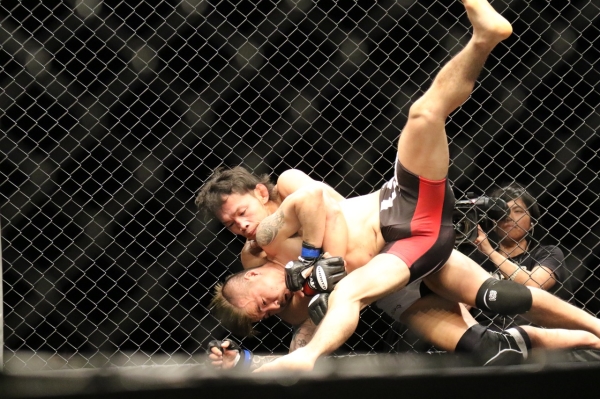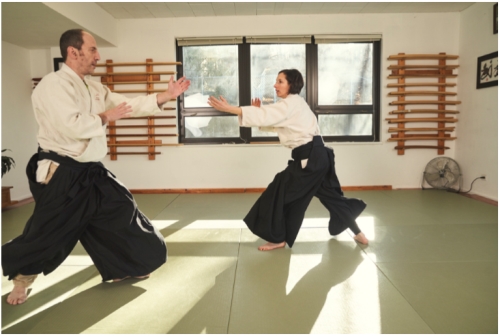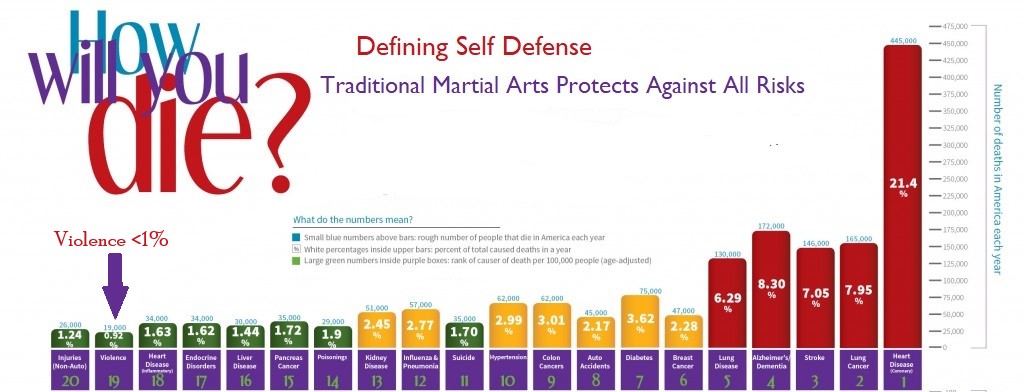Martial Arts, MMA Gyms & Compete Self Defense
What is Complete Self Defense?
MMA vs. Traditional Martial Arts


What are you really looking for?
The main threat to safety are injuries due to accidents and falls.
- 1) Train only for an assault?
- 2) Train for assault, safety & health, happiness
- Are you missing the main benefits of martial arts in daily life: Complete Self Defense & Conflict Resolution?
Did you know that your risk of dying from a violent attack is less than 1%? Did you also know that your risk of dying by age 57 if you engage in heavy contact combat sports might be 7% vs. 1% for everyone else? Some MMA gyms and hard core self defense programs have intense exercise but don't focus on the mental disciplines. The benefits are very narrow and can have collateral damage. A deep understanding of martial arts is critical, or you risk throwing the baby out with the bathwater, so to speak.
Lets take a closer look. People want to live long, healthy and happy lives. In traditional martial arts, self defense means to achieve precisely that - short run safety, long run health, peace and happiness. Both philosophy and an emphasis on improving health are part of the package. The approach works on all risks of dying. But if you strip out the philosophy and health benefits, you wind up only protecting yourself against the smallest risk (death by violent assault < 1%), while locking in long term health consequences with the most difficult exercise regime. Failure to understand the complete system of martial arts actually leads to minimum benefits with maximum effort. So in reality, the only way for the heavier contact combat systems to reverse the situation is to migrate towards the traditional martial arts system.
Defining Self Defense

Death by Violence less than 1% Risk
Contact Combat Sports Risk Long Run Health
Well Studied Similar Group: NFL
How Traditional Martial Arts Work
The stripped down combat approach may focus on techniques and heavy conditioning. But the philosophy of traditional martial arts focuses first on reducing the risk of ever being assaulted - for example, the instruction that "the best self defense is not being there." Reducing your own anger and building kindness in your day to day lifestyle, for example, can open a door to turn would be attackers into friends and make you happier in general. Improved situational awareness and respect for the possibility of being attacked leads to decisions that further reduces the danger.
One question is whether gyms are different from traditional martial arts or not. We don't define MMA so much by its physical training method as opposed to the mental discipline involved. MMA can be taught as a traditional martial art or self defense techniques. But if the latter, the benefits are limited and come with collateral damage.
Best Martial Art
What is the best martial art for you?Some people believe there is a "best martial art" - coincidentally the one they practice. In a sense this is true. The one YOU practice is the best martial art for YOU. The physical movements of any martial art can become effective if you train in it regularly and embed the reactions in your muscle memory. The point is to find the martial art that speaks to your disposition so you will train in it for a long period of time.
Then there is the emphasis on reducing injury and improving health. These are the more mainstream threats that people face. Tai chi is known for it's health benefits, and aikido teaches safe falling while it is designed as appropriate exercise across the age spectrum. The exercise also reduces the desire and propensity to become seriously overweight, as is roughly 70% of the population. This approach is well suited for most Americans as it avoids serious injury and health issues while providing healthy exercise for a lifetime.
So if you feel called to increase your sense of safety, health and confidence, you might consider traditional martial arts as an efficient approach offering a wide spectrum of benefits over a long period of time. In fact, achieving a similar assortment of benefits with only one practice is difficult to duplicate.
